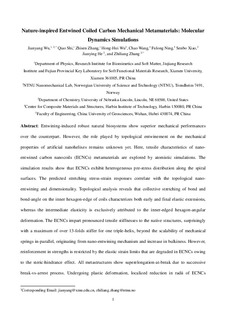| dc.contributor.author | Wu, Jianyang | |
| dc.contributor.author | shi, qiao | |
| dc.contributor.author | Zhang, Zhisen | |
| dc.contributor.author | Wu, Hong-Hui | |
| dc.contributor.author | Wang, Chao | |
| dc.contributor.author | Ning, Fulong | |
| dc.contributor.author | Xiao, Senbo | |
| dc.contributor.author | He, Jianying | |
| dc.contributor.author | Zhang, Zhiliang | |
| dc.date.accessioned | 2018-12-14T09:15:04Z | |
| dc.date.available | 2018-12-14T09:15:04Z | |
| dc.date.created | 2018-07-30T15:46:05Z | |
| dc.date.issued | 2018 | |
| dc.identifier.citation | Nanoscale. 2018, 10 15641-15653. | nb_NO |
| dc.identifier.issn | 2040-3364 | |
| dc.identifier.uri | http://hdl.handle.net/11250/2577687 | |
| dc.description.abstract | Entwining-induced robust natural biosystems show superior mechanical performances over the counterpart. However, the role played by topological entwinement on the mechanical properties of artificial nanohelixes remains unknown yet. Here, tensile characteristics of nano-entwined carbon nanocoils (ECNCs) metamaterials are explored by atomistic simulations. The simulation results show that ECNCs exhibit heterogeneous pre-stress distribution along the spiral surfaces. The predicted stretching stress-strain responses correlate with the topological nano-entwining and dimensionality. Topological analysis reveals that collective stretching of bond and bond-angle on the inner hexagon-edge of coils characterizes both early and final elastic extensions, whereas the intermediate elasticity is exclusively attributed to the inner-edged hexagon-angular deformation. The ECNCs impart pronounced tensile stiffnesses to the native structures, surprisingly with a maximum of over 13-folds stiffer for one triple-helix, beyond the scalability of mechanical springs in-parallel, originating from nano-entwining mechanism and increase in bulkiness. However, reinforcement in strengths is restricted by the elastic strain limits that are degraded in ECNCs owing to the steric-hindrance effect. All metastructures show superelongation-at-break due to successive break-vs-arrest process. Undergoing plastic deformation, localized reduction in radii of ECNCs develops to form carbyne-based networks. | nb_NO |
| dc.language.iso | eng | nb_NO |
| dc.publisher | Royal Society of Chemistry | nb_NO |
| dc.relation.uri | https://pubs.rsc.org/en/content/articlelanding/2018/nr/c8nr04507k#!divAbstract | |
| dc.title | Nature-inspired Entwined Coiled Carbon Mechanical Metamaterials: Molecular Dynamics Simulations | nb_NO |
| dc.title.alternative | Nature-inspired Entwined Coiled Carbon Mechanical Metamaterials: Molecular Dynamics Simulations | nb_NO |
| dc.type | Journal article | nb_NO |
| dc.description.version | submittedVersion | nb_NO |
| dc.source.pagenumber | 15641-15653 | nb_NO |
| dc.source.volume | 10 | nb_NO |
| dc.source.journal | Nanoscale | nb_NO |
| dc.identifier.doi | 10.1039/C8NR04507K | |
| dc.identifier.cristin | 1599026 | |
| dc.description.localcode | © 2018. This is the authors' manuscript to the article. The final authenticated version is available online at: http://dx.doi.org/10.1039/C8NR04507K | nb_NO |
| cristin.unitcode | 194,64,45,0 | |
| cristin.unitname | Institutt for konstruksjonsteknikk | |
| cristin.ispublished | true | |
| cristin.fulltext | preprint | |
| cristin.qualitycode | 1 | |
